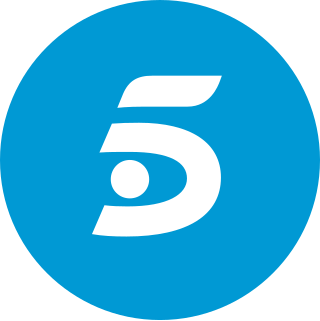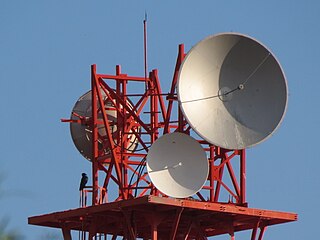
Telecinco is a Spanish free-to-air television channel operated by Mediaset España. The channel was previously known as Tele 5, because it had first begun its experimental transmissions on 10 March 1989, and a year later, it was officially launched on 3 March, 1990, becoming the fifth of the national terrestrial television channels and the second private channel in Spain. In 1997, Tele 5 was rebranded as Telecinco, dropping the biscione-absent flower logo seen in other Mediaset channel logos.

Once is a Mexican educational broadcast television network owned by National Polytechnic Institute. The network's flagship station is XEIPN-TDT channel 11 in Mexico City. It broadcasts across Mexico through nearly 40 TV transmitters and is required carriage on all Mexican cable and satellite providers. The network also operates an international feed which is available in the United States and Venezuela via satellite from DirecTV and CANTV, via online from VEMOX, VIVOplay and also on various cable outlets, on "Latino" or "Spanish" tiers. Most of its programs are also webcast through the Internet, though its programming is not the same as the actual broadcasters or satellite signal.

Canal 6 is a network of Spanish language television stations primarily concentrated in northeastern Mexico and the southwestern United States. The system is part of Grupo Multimedios. The flagship station of Multimedios is XHAW-TDT located in Monterrey, Nuevo León. Programming features locally produced news, sports, children's shows and general mass appeal variety programming. On weekdays, the network produces around twenty hours of live daily programming, with lesser amounts during the weekends and holidays.

A multiplex or mux, also known as a bouquet, is a grouping of program services as interleaved data packets for broadcast over a network or modulated multiplexed medium, particularly terrestrial broadcasting. The program services are broadcast as part of one transmission and split out at the receiving end.

XHWX-TDT is a television station in Monterrey, Nuevo León and Saltillo, Coahuila. Broadcasting on digital channel 19 in both cities, XHWX is a transmitter of the Azteca Uno network and the key station in the TV Azteca Noreste regional system, which provides regional news and sports content to Azteca's stations throughout northeastern Mexico.
Television in Spain was introduced in 1956, when the national state-owned public service television broadcaster Televisión Española (TVE) started regular analog free-to-air terrestrial black and white broadcasts. Colour transmissions started in 1972 after two years of test transmissions, with all programming transmitted in color in 1977, and colour commercials starting in 1978. TVE held a monopoly on television broadcasting until regional public channels were launched during the 1980s and commercial television started nationwide in 1990. Digital terrestrial television was launched on 30 November 2005 with analog service discontinued on 3 April 2010. Currently, television is one of the leading mass media of the country, and by 2008 was in 99.7% of households in Spain according to INE statistics.
XEDK-TDT is a television station in Guadalajara, Jalisco, broadcasting on virtual channel 13. Historically, XEDK was considered one of the most important local television stations in western Mexico; It forms part of the Telsusa Canal 13 network owned by Albavisión.

VA+ TV is a television station in Aguascalientes City, Mexico. It was established on October 12, 1976, with the support of the Instituto Cultural de Aguascalientes. It is part of Radio y Televisión de Aguascalientes, the public television and radio broadcaster for the state.
DMAX is a Spanish free-to-air television channel run by Warner Bros. Discovery and Unidad Editorial.

The Sistema Público de Radiodifusión del Estado Mexicano until 2014, is an independent Mexican government agency. Its mission is to support the development of public broadcasting in the country and expand its coverage. It carries out this goal through ownership of a nationwide network of transmitters and the management of its own public television channel, Canal Catorce. It also owns four radio transmitters.
This is a list of Spanish television related events from 2014.
Mega is a Spanish television channel owned by Atresmedia. Its programming is aimed towards a male audience.
This is a list of Spanish television related events from 2016.

Imagen Televisión is a national broadcast television network in Mexico, owned by Grupo Imagen. It launched on October 17, 2016, at 8 p.m.
XHFAMX-TDT, known as Heraldo Televisión, is a television station in Mexico City broadcasting on virtual channel 8. XHFAMX is owned by Heraldo Media Group, the company that operates the newspaper El Heraldo de México and the Heraldo Radio network. It was originally owned by Francisco Aguirre Gómez, chairman of Grupo Radio Centro, with the latter operating the station. XHFAMX took to the air from Grupo Radio Centro's tower on Cerro del Chiquihuite after having originally applied to build its transmitting facility at the Villa Alpina site in Naucalpan, State of Mexico, from which the company's Mexico City FM stations broadcast.
TRECE is a Spanish free-to-air television channel run by the Episcopal Conference of Spain, belongs to Radio Popular group together with the radio stations COPE, Rock FM, Cadena 100 and MegaStar FM and the TV network Popular TV.

Be Mad is a Spanish free television channel, belonging to Mediaset España and was launched on 21 April 2016. Its programming is cinema and film.

Ten is a Spanish free-to-air television channel run by Central Broadcaster Media, belongs to Grupo Secuoya.
Sociedad Gestora de Televisión Net TV, S.A. is a Spanish digital terrestrial television channel operator. The multiplex currently hosts two channels, Disney Channel and Paramount Network.

Canal 8 Mar del Plata is a television station broadcasting on channel 8 in Mar del Plata, Buenos Aires Province, Argentina. It carries programs from Telefe and is owned by Grupo Neomedia.











